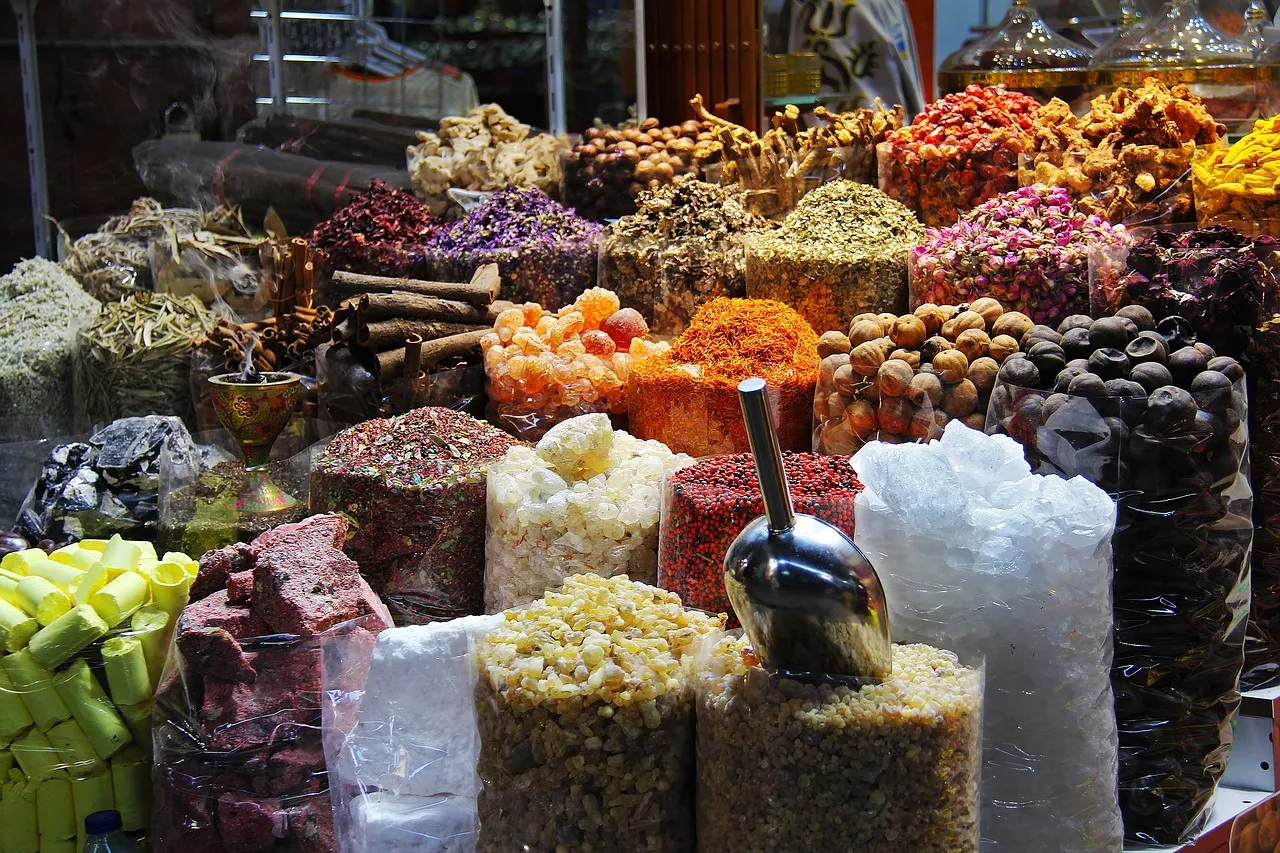Historical and Cultural Influences on Middle Eastern Food
Middle Eastern cuisine is a reflection of the region's rich history and diverse cultural influences. Over the centuries, the Middle East has been a crossroads for trade and conquest, resulting in a fusion of flavors and techniques. From the Persians to the Ottomans, each civilization has left its mark on the culinary landscape of the region.
The Arab conquests in the 7th century brought Islam to the Middle East and introduced a set of dietary laws known as Halal. This influenced the way food was prepared and consumed, with an emphasis on cleanliness and the prohibition of certain ingredients. Additionally, Persian and Ottoman influences brought an array of ingredients such as rice, saffron, and kebabs to the Middle Eastern table.
The spice trade also played a significant role in shaping Middle Eastern cuisine. Spices like cinnamon, cumin, and cardamom were highly sought after and became integral to the flavor profiles of many dishes. The Silk Road, which connected the Middle East to Asia, brought exotic spices such as turmeric and ginger to the region, further enriching its culinary traditions.
Common Ingredients in Middle Eastern Cuisine
Middle Eastern cuisine is characterized by a vibrant array of ingredients that come together to create bold and complex flavors. From fragrant herbs to robust spices, these ingredients form the foundation of many traditional dishes.
One staple ingredient in Middle Eastern cuisine is olive oil. Known for its health benefits and distinct flavor, olive oil is used in everything from salad dressings to marinades. Another essential ingredient is tahini, a paste made from ground sesame seeds. Tahini is a key component in dishes like hummus and baba ganoush, lending a creamy texture and nutty flavor.
Herbs and spices are also integral to Middle Eastern cooking. Parsley, mint, and cilantro are commonly used to add freshness and brightness to dishes. Spices like cumin, coriander, and sumac are used to enhance flavors and provide a warm, earthy undertone. Za'atar, a blend of herbs, sesame seeds, and sumac, is a popular spice mix used as a seasoning or dip.
Traditional Middle Eastern Dishes
Middle Eastern cuisine boasts a variety of traditional dishes that have stood the test of time. These dishes reflect the region's diverse culinary heritage and are often enjoyed as part of a shared meal.
Hummus, a smooth and creamy dip made from chickpeas, is a beloved Middle Eastern classic. It is typically served with warm pita bread and garnished with olive oil, paprika, and fresh herbs. Another iconic dish is falafel, crispy deep-fried balls made from ground chickpeas or fava beans. Falafel is often served in a pita pocket with a variety of toppings and sauces.
Shawarma, a popular street food, is a flavorful combination of marinated meat (such as chicken, beef, or lamb), slow-roasted on a vertical spit. The tender and juicy meat is thinly sliced and served in a wrap or on a plate with accompaniments like pickles, tahini sauce, and garlic sauce. Kebabs are also a staple in Middle Eastern cuisine, with various meat skewers grilled to perfection and served with rice or flatbread.
Popular Middle Eastern Street Food
Middle Eastern street food offers a tantalizing experience for food enthusiasts. The vibrant markets and bustling streets of the region are filled with the aroma of sizzling meats, freshly baked bread, and aromatic spices.
One popular street food is manakish, a Lebanese flatbread topped with za'atar, cheese, or a combination of both. It is often eaten for breakfast or as a quick snack. Shawarma stalls are also a ubiquitous sight, with the tantalizing aroma of slow-roasted meat drawing in hungry passersby. The meat is carved right in front of you and wrapped in warm pita bread, creating a delicious handheld meal.
Another street food favorite is koshari, an Egyptian dish that combines rice, lentils, macaroni, and chickpeas, topped with a tangy tomato sauce and crispy fried onions. It's a hearty and satisfying meal that showcases the flavors and textures of the region.
Middle Eastern Desserts and Sweets
No Middle Eastern meal is complete without indulging in the region's delectable array of desserts and sweets. Middle Eastern sweets are renowned for their intricate designs, delicate flavors, and use of ingredients like honey, nuts, and rosewater.
Baklava, a pastry made of layers of filo dough filled with a mixture of chopped nuts, sugar, and spices, is a perennial favorite. It is often drizzled with a sweet syrup infused with rosewater or orange blossom water, adding a fragrant touch. Another popular dessert is kunafa, a sweet cheese pastry soaked in a sugar syrup and topped with crunchy vermicelli noodles.
Rosewater and cardamom-infused puddings, such as muhallabia and mahalabia, offer a creamy and aromatic treat. These desserts are often garnished with pistachios or almonds for added crunch. Turkish delight, a gelatinous sweet flavored with rosewater, lemon, or various fruits, is another beloved Middle Eastern confectionery.
Health Benefits of Middle Eastern Food
Middle Eastern cuisine is not only a feast for the taste buds but also offers a range of health benefits. With its emphasis on fresh ingredients, whole grains, and lean proteins, Middle Eastern food provides a nutritious and balanced diet.
The abundant use of olive oil in Middle Eastern cooking is associated with numerous health benefits. Olive oil is rich in monounsaturated fats, which can help reduce bad cholesterol levels and lower the risk of heart disease. Herbs and spices used in Middle Eastern dishes, such as turmeric and cumin, have long been recognized for their anti-inflammatory and antioxidant properties.
Legumes like chickpeas and lentils are a staple in Middle Eastern cuisine and are excellent sources of plant-based protein and fiber. These ingredients contribute to a feeling of fullness, aid in digestion, and help regulate blood sugar levels. Additionally, the inclusion of a variety of vegetables and fruits in Middle Eastern dishes provides a wide range of essential vitamins and minerals.
Middle Eastern Cooking Techniques and Methods
Middle Eastern cooking techniques have been honed over centuries, resulting in dishes that are bursting with flavor and texture. One technique commonly used is grilling, which imparts a smoky char to meats and vegetables. Skewered meats like kebabs are traditionally cooked over an open flame, giving them a distinctive taste.
Another technique is slow cooking, which allows flavors to meld together and meats to become tender and succulent. Dishes like stews and tagines are often cooked slowly over low heat, allowing the ingredients to release their full potential.
Middle Eastern cuisine also embraces the art of pickling and preserving. The process of pickling, using ingredients like vinegar, lemon juice, and salt, adds tanginess and extends the shelf life of vegetables and fruits. This technique is commonly used to create flavorful condiments such as pickled turnips and olives.
Middle Eastern Food Festivals and Celebrations
Middle Eastern culture places great importance on food, and this is evident in the numerous food festivals and celebrations that take place throughout the year. These events showcase the region's culinary heritage and bring communities together in a celebration of food and culture.
One such festival is Eid al-Fitr, which marks the end of Ramadan, the Islamic holy month of fasting. Families gather to share a festive meal known as Eid al-Fitr feast, which includes dishes like biryani, lamb, and a variety of sweets. The festival creates a sense of unity and joy as people come together to break their fast and celebrate.
Another notable celebration is Nowruz, the Persian New Year. Nowruz is a time of renewal and is celebrated with a traditional meal called Haft-Seen, which includes seven symbolic items representing luck and prosperity. The meal typically consists of dishes like sabzi polo (herb rice) and dolmeh (stuffed vegetables), highlighting the freshness and abundance of springtime.
Conclusion: Embracing the Diversity and Flavors of Middle Eastern Cuisine
Middle Eastern cuisine is a true testament to the region's rich history, cultural diversity, and love for food. From the humble falafel cart to lavish banquets, Middle Eastern cuisine offers a sensory experience that is both satisfying and nourishing.
By understanding the historical and cultural influences on Middle Eastern food, appreciating the common ingredients used, and exploring traditional dishes, street food, and desserts, we can fully immerse ourselves in the vibrant flavors of the region. We can also appreciate the health benefits of Middle Eastern food and the cooking techniques that contribute to its unique taste.
So, let us embrace the diversity and flavors of Middle Eastern cuisine, and allow ourselves to be transported on a culinary journey through the ancient traditions and modern taste buds that make Middle Eastern food a true masterpiece. Savor the aromas, indulge in the spices, and experience the warmth and hospitality that are at the heart of Middle Eastern cooking.

 September Recipes to Try at Home
September Recipes to Try at Home The Roadmap to Self-Taught Cooking Excellence
The Roadmap to Self-Taught Cooking Excellence



